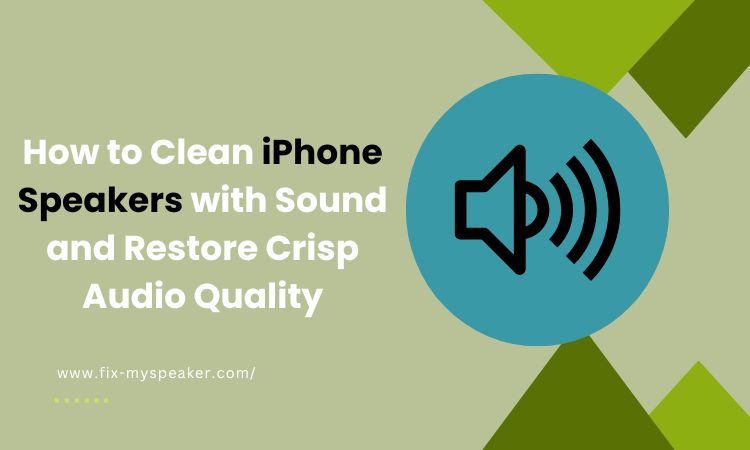How to Clean iPhone Speakers with Sound
Clear iPhone speakers with sound!
MODE
PRESS TO EJECT WATER
Have you noticed your iPhone’s sound isn’t as crisp as it used to be? Muffled audio, low volume, or crackling noises can be frustrating—especially when you’re on a call or listening to music. The culprit? Dust and dirt trapped in your speakers.
But here’s the good news: you don’t need fancy tools or risky cleaning methods to fix it. There’s a simple and safe way—how to clean iPhone speakers with sound. This technique uses specific sound frequencies to shake out trapped dust without damaging your device.
This article will walk you through the process step by step, reveal the best frequencies to use, and share essential tips to keep your speakers in top shape. Let’s get your iPhone sounding brand new again!
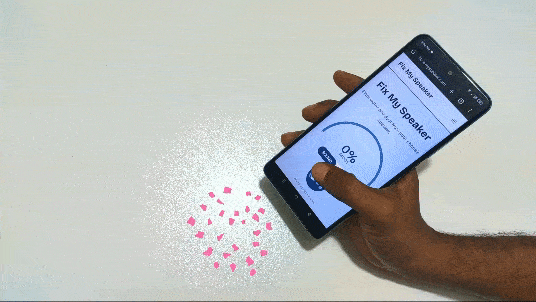
Can You Really Clean iPhone Speakers with Sound?
Yes, you can clean iPhone speakers with sound by playing specific frequencies that create vibrations to shake out dust and debris. This method is safe, requires no physical tools, and helps restore clear audio. Using apps or online sound generators improves the cleaning process effectively.
Your iPhone speakers can collect dust over time, leading to muffled or distorted sound. Instead of using sharp objects or compressed air, playing specific sound frequencies helps loosen and push out trapped particles. These frequencies create vibrations that gently shake the debris from the speaker openings.
You can use dedicated speaker-cleaning apps like Fix My Speaker or YouTube videos that generate the right sound waves. To make this method more effective, place your phone with the speaker side facing downward and play the sound at a moderate volume.
While this technique works well for minor dust buildup, stubborn debris may require additional manual cleaning.
Signs Your iPhone Speakers Need Cleaning
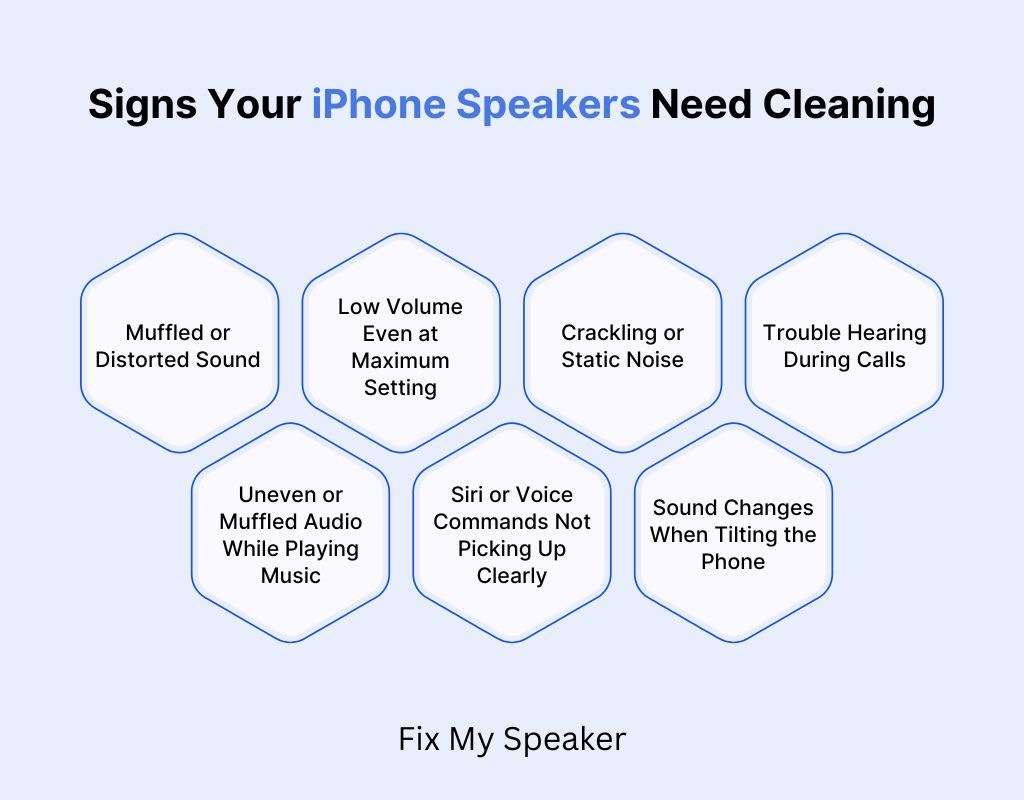
Over time, dust and dirt can build up in your iPhone speakers, affecting sound quality. If you’re noticing issues with your audio, here are the key signs that your speakers need cleaning:
Muffled or Distorted Sound
If your iPhone’s sound seems unclear, weak, or distorted, dust or debris may be blocking the speaker grill. You might struggle to hear calls, music, or videos properly, even at full volume. Cleaning your speakers with sound can help restore their clarity without causing damage.
Low Volume Even at Maximum Setting
When your iPhone’s volume feels lower than usual, even when turned up all the way, it could mean dust is preventing sound from coming through properly. A quick cleaning using sound waves can help clear out trapped particles and bring back the full volume.
Crackling or Static Noise
If you hear crackling, buzzing, or static noises while playing music or during calls, your speakers might be clogged with dust. These sounds indicate sound waves struggling to pass through debris, making your audio less clear.
Trouble Hearing During Calls
If you frequently ask people to repeat themselves because voices sound faint or unclear, your earpiece speaker might be blocked. This can affect call clarity, making conversations difficult. Cleaning your iPhone speaker with a soft brush can help restore clear voice transmission.
Uneven or Muffled Audio While Playing Music
When listening to music, if one speaker sounds quieter than the other, or the audio feels unbalanced, debris buildup could be the cause. Dirt can block parts of the speaker grill, disrupting sound flow.
Siri or Voice Commands Not Picking Up Clearly
If Siri struggles to recognize your voice or dictation is inaccurate, dust buildup in the microphone or speakers could be interfering. This can impact voice clarity, making commands harder to process.
Sound Changes When Tilting the Phone
If the sound improves or worsens when you tilt or shake your iPhone, it may indicate loose dust or debris shifting inside the speaker grill. This suggests that a proper cleaning using sound frequencies could help remove the particles stuck in the speakers.
How to Clean iPhone Speakers with Sound
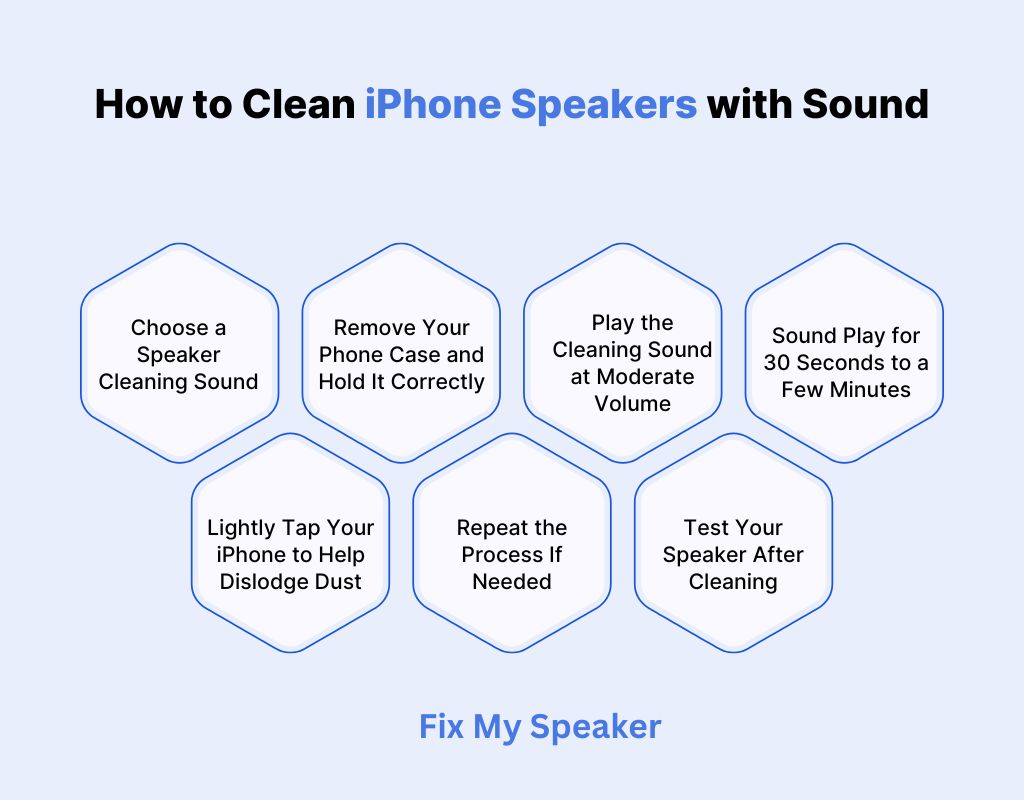
If your iPhone speakers sound muffled or distorted, cleaning them with sound is a safe and effective way to remove dust. Here’s a step-by-step guide on how to clean iPhone speakers with sound:
Choose a Speaker Cleaning Sound
Find a speaker-cleaning app like Fix My Speaker that plays a low-frequency sound (100Hz-300Hz). These sound waves create vibrations that help loosen and push out dust particles stuck in the speaker grill. Using the right frequency makes the cleaning process much more effective.
Remove Your Phone Case and Hold It Correctly
Take off any phone case before starting, as it might block the sound waves from working effectively. Hold your iPhone with the speaker side facing downward. This way, when the sound vibrates the dust loose, it can fall out easily instead of getting trapped inside the speaker.
Play the Cleaning Sound at Moderate Volume
Start playing the cleaning sound at a medium volume level and gradually increase it if needed. Avoid using full volume, as extremely high sound levels could put unnecessary stress on your speakers. The vibrations at moderate volume work best to shake out dust without harming the speaker components.
Let the Sound Play for 30 Seconds to a Few Minutes
Let the cleaning sound play for at least 30 seconds to a few minutes, depending on how clogged your speakers are. If dust buildup is heavy, you may need to let it play for a longer period. Watch closely—sometimes, you can see small dust particles being expelled.
Lightly Tap Your iPhone to Help Dislodge Dust
While the sound is playing, gently tap your iPhone near the speakers to help loosen any stubborn dust stuck inside. Be careful not to tap too hard, as excessive force may damage internal components. This small action can make the cleaning process much more effective.
Repeat the Process If Needed
If your speakers still sound muffled after one attempt, repeat the process. Some debris may be harder to remove and require multiple cleaning cycles. Playing the cleaning sound two or three times in a row can increase the chances of clearing out all trapped dust and dirt.
Test Your Speaker After Cleaning
Once you’ve finished playing the cleaning sound, test your iPhone’s speakers by playing music, making a call, or using Siri. If the sound is clearer and louder than before, the cleaning was successful. If not, you may need to try other gentle cleaning methods.
Best Sound Frequency Tools to Clean iPhone Speakers
If you want to clean your iPhone speakers using sound, you need the right tools that generate effective frequencies. Here are the top 5 sound frequency tools that help remove dust and improve audio clarity:
Fix My Speaker (Website & App)
Fix My Speaker is a popular web-based and mobile tool that plays a water-ejection and dust-removal sound. It uses low-frequency vibrations to push out trapped debris from your speakers. Just visit their website or download the app, press the button, and let the sound work its magic.
Sonic (iOS App)
Sonic is a powerful iOS app that lets you generate custom sound frequencies ranging from 0Hz to 25,000Hz. You can select the ideal cleaning frequency (100Hz-300Hz) and adjust the volume to dislodge dust from your iPhone speakers. It’s easy to use and effective for regular cleaning.
Speaker Cleaner – Remove Water & Dust (iOS & Android App)
This app is designed specifically to clear out water, dust, and debris from speakers using pre-set cleaning tones. It automatically plays different frequencies optimized for speaker cleaning. Simply launch the app, press the clean button, and let the sound waves do the work.
YouTube Speaker Cleaning Sounds (Free Online Videos)
YouTube offers several pre-recorded cleaning sound videos designed to dislodge dust from speakers. Just search for “iPhone speaker cleaning sound” or “speaker dust removal frequency,” and you’ll find multiple videos with the right frequencies. Play them at moderate volume while holding your phone downward.
Online Tone Generator (Website)
This free website allows you to generate and play custom sound frequencies for speaker cleaning. You can enter a specific frequency (100Hz-300Hz), adjust the volume, and let the sound waves clear out dust. It’s simple, effective, and works without needing to install an app.
Alternative Methods to Clean iPhone Speakers
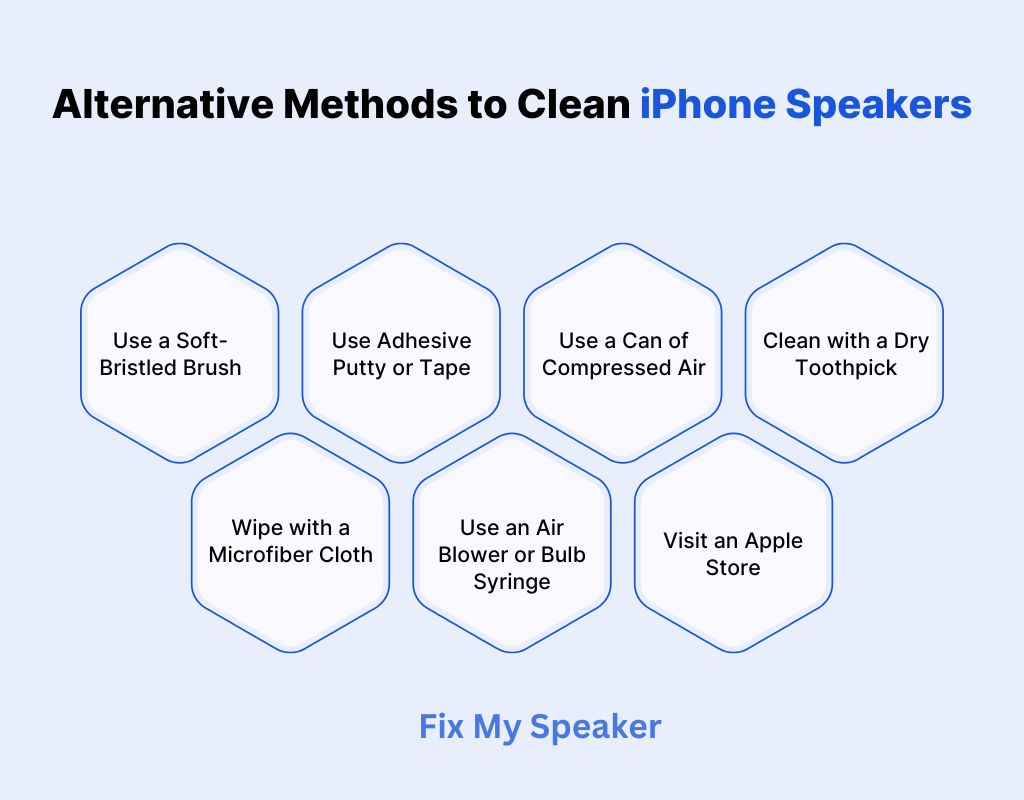
If sound cleaning doesn’t fully restore your iPhone speakers, you can try other safe methods. Here are some alternative ways to clean iPhone speakers without damaging your device:
Use a Soft-Bristled Brush
Gently brush the speaker grill using a soft-bristled toothbrush or an electronics cleaning brush to remove dust and dirt. Brush in a circular motion without applying too much pressure. This method helps dislodge stuck particles without pushing debris further into the speaker openings.
Use Adhesive Putty or Tape
Take a small piece of adhesive putty or painter’s tape, press it gently onto the speaker grill, and peel it off. The sticky surface helps lift out dust and lint trapped inside. This is a safe and effective method that doesn’t require any liquid or harsh tools.
Use a Can of Compressed Air (With Caution)
Hold a can of compressed air at a slight angle and spray in short bursts to remove dust. Keep a safe distance (at least 6 inches) to avoid pushing dirt further inside. Avoid holding the can too close, as high-pressure air can damage delicate speaker components.
Clean with a Dry Toothpick (Be Very Gentle)
If dirt is stuck in the speaker holes, use a dry wooden toothpick to carefully scrape out debris. Be extremely gentle to avoid damaging the speaker mesh. Instead of inserting the toothpick deeply, lightly sweep along the surface to lift out dust.
Wipe with a Microfiber Cloth
Dampen a microfiber cloth with a little isopropyl alcohol (not dripping wet) and gently wipe around the speaker area. This helps remove dust and oil buildup. Avoid letting any liquid enter the speaker openings, as moisture can damage internal components.
Use an Air Blower or Bulb Syringe
A manual air blower or a bulb syringe (like the ones used for cameras) can gently blow dust out of the speaker grill. Unlike compressed air, this method provides a softer airflow that won’t risk forcing dust deeper inside.
Visit an Apple Store for Professional Cleaning
If none of these methods work and your speakers still sound muffled, consider getting professional cleaning at an Apple Store or an authorized repair center. They have specialized tools to safely remove debris without causing any damage to your iPhone’s internal components.
Common Mistakes to Avoid When Cleaning iPhone Speakers
Cleaning your iPhone speakers the wrong way can cause more harm than good. To keep your speakers safe and functional, here are common mistakes you should avoid while cleaning them:
Blowing Air Directly Into the Speaker
Blowing into the speaker with your mouth may seem harmless, but it can push moisture or saliva inside, leading to long-term damage. Instead, use a manual air blower or compressed air (from a safe distance) to dislodge dust without introducing moisture.
Spraying Liquids or Using Wet Cloths
Never spray water, cleaning sprays, or any liquid directly onto the speaker. Even small amounts of moisture can damage internal components. If needed, use a lightly damped microfiber cloth to wipe around the speaker area without letting liquid enter.
Playing Sounds at Extremely High Volume
While cleaning iPhone speakers with sound is effective, playing high-frequency sounds at maximum volume for too long can strain the speakers. Instead, use moderate volume and the right frequencies (100Hz-300Hz) to safely remove dust without risking speaker damage.
Using Compressed Air Too Closely
Compressed air can help remove dust, but if you hold the can too close or use too much pressure, it might push debris further inside or damage the speaker grill. Always keep the nozzle at least 6 inches away and use short bursts instead of continuous air pressure.
Ignoring Regular Maintenance
Waiting until your speakers sound completely muffled before cleaning them can make the problem worse. Dust builds up over time, so it’s best to clean your speakers regularly using sound or a soft brush to prevent blockages and maintain clear audio.
Not Testing the Speaker After Cleaning
After cleaning, always test your iPhone speakers by playing music or making a call. This helps you check if the cleaning worked or if additional steps (like repeating the sound method or using adhesive putty) are needed to remove remaining debris.
Conclusion
Cleaning your iPhone speakers doesn’t have to be complicated. Now that you know how to clean iPhone speakers with sound, you can keep your device sounding crisp without using sharp tools or risky methods.
This simple technique helps remove dust safely using specific sound frequencies, restoring clear audio for calls, music, and videos.
To maintain long-term speaker performance, clean them regularly and avoid exposure to dust and moisture. A little care goes a long way in keeping your audio crisp and clear. With these simple steps, you can enjoy the best sound quality on your iPhone for calls, music, and videos.
FAQs
Can I play the cleaning sound from YouTube?
Yes, YouTube has various cleaning sound videos that produce the right frequencies to remove dust from your iPhone speakers. Simply search for “iPhone speaker cleaning sound” and play it at a moderate volume. Hold your phone with the speakers facing downward for better results.
Can I clean iPhone speakers with sound if my phone has a case on?
No, it’s best to remove the case before playing the cleaning sound. Some cases can muffle the sound waves, reducing their effectiveness in dislodging dust. Without a case, the vibrations travel more efficiently through the speakers, improving the chances of clearing out trapped debris.
Will this sound cleaning method work on all iPhone models?
Yes, this method works on all iPhone models with speaker grills. Whether you have an older iPhone or the latest model, sound vibrations help remove dust. However, for iPhones with smaller speaker openings, additional manual cleaning may be needed for the best results.
